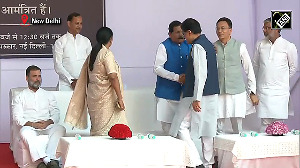'The primary set took over three months to build with 14,000-15,000 workers employed at a time.'
'We ensured that Mallikajaan's Shahi Mahal lived up to its name.'
'One zardosi panel cost around Rs 4 lakh; the one with the kalpavriksh was around Rs 5 lakh.'

Amit Ray and Subrata Chakraborty are familiar names in Hindi film circles. The National Award-winning art directors and production designers have several period extravaganzas to their credit, including Vishal Bhardwaj's Haider and Rangoon, Meghna Gulzar's Raazi and Sam Bahadur, and Sanjay Leela Bansali's Padmaavat, Gangubai Kathiawadi and more recently, Heeramandi.
While the Netflix series has drawn its share of criticism for certain performances and even a somewhat filmi and flimsy plotline, the sets, props and costumes have turned it into an eye-catching spectacle.
"Heeramandi is more of a man's fantasy rather than a real world, a distinction that many detractors fail to understand," Ray and Chakraborty tells Rediff.com Senior Contributor Roshmila Bhattacharya.
We were to build just one set, but we ended up making 40-45 sets

We started Heeramandi last year, in January-February, while simultaneously working on Rajkumar Hirani's Dunki.
Initially, the idea was to build one primary set, then hand over the project to someone else.
Back then even Sanjay (writer-producer-director Sanjay Leela Bhansali) sir was supposed to direct just one episode before passing on the baton to one of his assistants.
But we ended up making 40-45 sets and dressing up six-seven acres of land.
Sunil Maidan near Mumbai's Film City studio on which many of Sanjay sir's sets have been built, including Padmaavat and Gangubai Kathiawadi for which we did the production design, was home for Heeramandi too.
One zardosi panel cost us around Rs 4 lakh

The biggest challenge we faced was that there were few references since we couldn't visit the real Heera Mandi in the walled city of Lahore and had to rely primarily on the Internet for research.
Not that it would have helped because our Heeramandi is a period series set before Partition and has little resemblance to the Heera Mandi of today which is more like the red light district of Pakistan.
Back then, tawaifs were courtesans, well versed in arts and culture, who hosted royalty and lived extravagantly, which is why the area around Lahore fort was called the Shahi Mohallah or the 'Royal Neighbourhood'.
We ensured that Mallikajaan's Shahi Mahal lived up to its name.
One zardosi panel cost us around Rs 4 lakh; the one with the kalpavriksh was around Rs 5 lakh.
Sanjay sir has a grand vision and we had to bring his larger-than-life, lavishly-mounted world to the screen with his signature style.
But like Devdas is not a true representation of Bengal's culture, Heeramandi too is more a man's fantasy rather than a real world, a distinction that many detractors fail to understand.
The primary set took over three months to build

We worked day and night because back then Sanjay sir wanted to start shooting immediately; the shoot was later delayed because of the dates of artistes.
But we finished our work, which included the Shahi Mahal, Khwabgah where Fareedan rules, Nawab Tajdar Baloch's two homes, the library, the market square, the masjid, along with umpteen rooms in the palaces within the deadline given.
The primary set took over three months to build with 14,000-15,000 workers employed at a time and around 14-15 assistants supervising them.
Once that was in place, the changeovers were easier and faster, with one part of the set turning into Alamzeb's room and another the central hall where Bibbojaan performs her last dance and Alamzeb makes her debut as a tawaif before she is interrupted by news of Tajdar's death.
The most difficult set was Khwaabgah

Besides erecting the sets, we also had to dress them up.
Nothing was factory bought, each chandelier was made on the set and every wall hand painted.
The etchings on glass and the carvings on the pillars are all real and not computer generated.
The most difficult set was undoubtedly Khwaabgah.
For the flooring, we used marble and each stone was cut piece by piece.
In a top shot of Fareedan's room you can see the intricate flooring and the wall panels.
The architecture in Padmaavat, Gangubai and Kalank is different

Sanjay sir has seen Mughal-e-Azam innumerable times, he knows every frame and would give us examples from K Asif's epic extravaganza during Padmaavat, Gangubai Kahthiawadi and Heeramandi.
But nothing was copied from any film.
There have been comparisons with Kalank, but not a single arch is the same, the quality of work is very different.
We did not replicate or reuse a single set, not even the drapes and dupattas.
The architecture in Padmaavat, Gangubai Kathiawadi and Kalank is very different.
Case to point the windows with their wooden shutters which are nothing like the Rajasthani jharokhas with their stone pillars, balustrade, pyramidal roof and jali in Padmaavat.
Even the clay tiles on the roofs of the buildings in Lahore then are different.
Back in the '40s, before the country was divided on communal lines by the British, 90 per cent of the shopkeepers in Heera Mandi were Hindus doing brisk business in milk and lassi. Many of the houses have pictures of Hindi gods or 'Om' on their roofs.
Lahore 1947 is nothing like Heeramandi

Currently, we are working on Rajkumar Santoshi's Lahore 1947.
As the title indicates, it's a period film set in Lahore, but it is nothing like Heeramandi.
We have built two main sets for Sunny Deol and Preity Zinta's post-Partition drama.
Sunny's haveli has been built in Vrindavan, Madh Island (off the coast of Mumbai), but the major portion of the film is being shot at the SRPF Ground in Jogeshwari (north west Mumbai).
Heeramandi is a perfect example of colour blending

Working with Sanjay sir is a lot of fun, he loves hand-painted drawings and playing with colours.
Heeramandi is a perfect example of colour blending, with the walls, props and the costumes perfectly coordinated.
The colours, even the yellows and reds, are soothing because Sanjay sir hates even his crew wearing garish colours.
If we ever wore a jhatka shirt on his set, he would go, "Hmmm."
For him it's all about subtle tones and textures.
He follows old masters, like Raja Ravi Verma's calendar art, so even a film like Gangubai Kathiawadi, set in Mumbai's red-light neighbourhood Kamathipura, is beautiful with curtains made of saris and etchings on the walls.
In Heeramandi every frame is like a painting in itself.
The series projected India as a sone ki chidiya

For us the biggest achievement is that the series projected India not as a gareeb country, but as the proverbial sone ka chidiya, which translates literally as 'golden bird' but actually means 'a highly valued prize'.
There's a widely circulated story on social media of a maharaja who in the 1920s, strolling through the streets of London, entered a Rolls Royce showroom in casual wear and enquired about the prices of the cars.
The British salesman believed he could not afford such an expensive English car and showed him the exit.
Humiliated, the maharaja made a formal appointment, and returning to the showroom, bought all six cars, paying in cash.
He then had them shipped to India where he used them to collect garbage till the Rolls Royce company apologised and gifted him half-a-dozen more cars.
That's the glorified image of India Sanjay sir brings on screen, putting our country on top of the global map.
The man is not just a film-maker, he is an artist, which is why once shooting is complete, he spends three days on the set alone, reliving the experience, before he moves to his next celluloid dream.












 © 2025
© 2025